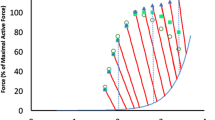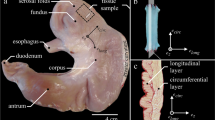Summary
The extent of shortening in smooth muscle tissues is limited by a number of internal and external factors. In this study, continuous measurements of the stiffness of active muscle were made to characterize the mechanical forces acting to limit shortening. Rabbit ovarian ligament and mesotubarium superius muscles were allowed to shorten as far as possible under light afterloads; under these conditions a stiffness increase was observed that was closely related to the instantaneous muscle length and that was unaffected by other factors influencing the degree of shortening (afterload, time and intensity of activation, temperature, etc.). The results are considered in terms of a hypothesis relating the tissue-based constraints on radial expansion at short lengths to an additional load on the contractile apparatus, an internal force that is externally manifested as an increase in axial stiffness. Changing the cellular volume by varying the tonicity of the bathing medium provided tentative confirmation of the hypothesis.
Similar content being viewed by others
References
Arheden, H., Arner, A. &Hellstrand, P. (1987) Force-velocity relation and rat of ATP hydrolysis in osmotically compressed skinned smooth muscle of the guinea pig.J. Muscle Res. Cell Motil. 8, 151–60.
Butler, T. M., Siegman, M., &Mooers, S. U. (1983) Chemical energy usage during shortening and work production in mammalian smooth muscle.Am. J. Physiol. 244, C234-C242.
Driska, S. P., Damon, D. N. &Murphy, R. A. (1978) Estimates of cellular mechanics in an arterial smooth muscle.Biophys. J. 24, 525–40.
Fay, F. S. &Delise, C. M. (1973) Contraction of isolated smoothmuscle cells — structural changes.Proc. Natl. Acad. Sci. USA70, 641–5.
Ford, L. E., Huxley, A. F. &Simmons, R. M. (1981). The relation between stiffness and filament overlap in stimulated frog muscle fibres.J. Physiol. (London)311, 219–49.
Gabella, G. (1976) Structural changes in smooth muscle cells during isotonic contraction.Cell Tissue Res. 170, 187–201.
Gabella, G. (1984) Structural apparatus for force transmission in smooth muscles.Physiol. Rev. 64, 455–77.
Gabella, G. (1989) Development of smooth muscle: ultra-structural study of the chick embryo gizzard.Amt. Embryol. 180, 213–26.
Gordon, A. M., Huxley, A. F. &Julian, F. J. (1966) The variation in isometric tension with sarcomere length in vertebrate muscle fibres.J. Physiol. (Lond.)184, 170–92.
Halpern, W., Mulvany, M. J. &Warshaw, D. M. (1978) Mechanical properties of smooth muscle cells in the walls of arterial resistance vessels.J. Physiol. (Lond.)275, 85–101.
Harris, D., Yamakawa, M. &Warshaw, D. M. (1989) Evidence for an internal load in single smooth muscle cells.Biophys. J. 55, 68a.
Hellstrand, P., Arheden, H. &Arner, A. (1988) Mechanical characteristics of the contractile system in smooth muscle.J. Muscle Res. Cell Motil. 9, 475–8.
Meiss, R. A. (1975) Graded activation in rabbit mesotubarium smooth muscle.Am. J. Physiol. 229, 455–65.
Meiss, R. A. (1978) Dynamic stiffness of rabbit mesotubarium smooth muscle: effect of isometric length.Am. J. Physiol. 234, C14-C26.
Meiss, R. A. (1984) Non-linear force response of active smooth muscle subjected to small stretches.Am. J. Physiol. 246, C114-C124.
Meiss, R. A. (1987) Stiffness of active smooth muscle during forced elongation.Am. J. Physiol. 253, C484-C493.
Meiss, R. A. (1990) The effect of tissue properties on smooth muscle mechanics. InFrontiers in Smooth Muscle Research (edited by Sperelakis, N. & Wood, J. D.) pp. 435–49. New York: Alan R. Liss.
Meiss, R. A. (1991) An analysis of length-dependent active stiffness in smooth muscle strips. InAdvances in Experimental Biology and Medicine: Regulation of Smooth Muscle (edited by Moreland, R. S.). New York: Plenum Press (in press).
Mullins, G. L. &Guntheroth, W. G. (1965) A collagen net hypothesis for force transference of smooth muscle.Nature 205, 592–4.
Price, J. M., Davis, D. L. &Knauss, E. B. (1981) Length-dependent sensitivity in vascular smooth muscle.Am. J. Physiol. 241, H557-H563.
Seow, C. Y. &Stephens, N. L. (1986) Force-velocity curves for smooth muscle: analysis of internal factors reducing velocity.Am. J. Physiol. 251, C362-C368.
Siegman, M. J., Butler, T. M. &Mooers, S. U. (1984) Energetic, mechanical and ultrastructural correlates of the lengthtension relationship in smooth muscle. InSmooth Muscle Contraction (edited by Stephens, N. L.) pp. 189–98. New York: Marcel Dekker.
Wang, Z. &Stephens, N. L. (1989) Normally cycling and latch bridges in venous smooth muscle.Blood Vessels 26, 272–9.
Warshaw, D. M., Desrosiers, J. M., Work, S. S. &Trybus, K. M. (1990) Smooth muscle myosin crossbridge interactions modulate actin filament sliding velocityin vitro.J. Cell Biol. 111, 453–63.
Yamakawa, M., Harris, D. &Warshaw, D. M. (1989) Effects of calcium and temperature on isometric tension transients from intact single smooth muscle cells.Biophys. J. 55, 69a.
Author information
Authors and Affiliations
Rights and permissions
About this article
Cite this article
Meiss, R.A. Limits to shortening in smooth muscle tissues. J Muscle Res Cell Motil 13, 190–198 (1992). https://doi.org/10.1007/BF01874156
Received:
Revised:
Accepted:
Issue Date:
DOI: https://doi.org/10.1007/BF01874156




